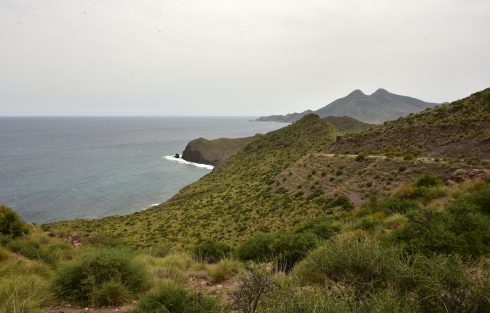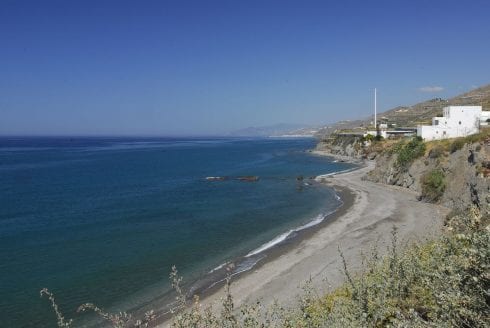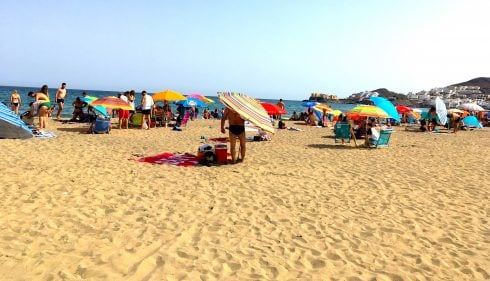FORMED by volcanoes, Cabo de Gata is one of the most unspoilt paradises on the Almerian costa, if not the entire south coast of Spain. Its amazing landscapes were created by the weathering of magma that erupted from the earth 15-16 million years ago.
The visible part of a landmass that lies under the Alboran Sea, Cabo de Gata boasts 120 km2 of maritime Natural Park, stretching along 50 km of beautiful coastline. This runs from the town of Cabo de Gata to the south, on the Bay of Almeria, to Carboneras in the north, limited by the Sierra de Cabrera.
With volcanic outcrops snaking into the sea, you could be forgiven for thinking that you’re surrounded by giant prehistoric creatures, such as dinosaurs or crocodiles, that are slumbering peacefully. The whole landscape looks as if time stood still.






In a way, it did. Cabo de Gata escaped the development surge of the 1970s. Encouraged by Franco, who died in 1975, this era saw much of the Spanish ‘costas’ inundated with high rise hotels and other amenities aimed at overseas tourists (mainly Brits).
Meanwhile, Cabo de Gata remained almost untouched, allowing some rare forms of fauna and flora to survive, and small villages to remain diminutive. It is a land of eucalyptus, palms and cacti. The Natural Park itself is strictly protected against development – unlike the vast swathes of land covered with plastic greenhouses that you’ll see throughout Almeria. These are used to produce fruit and vegetables that are largely exported.
Where to stay
To make the most of a short break in Cabo de Gata, a good plan is to book accommodation in the middle of the Natural Park, meaning everything is within easy reach via a network of roads (or walking routes, if that’s your thing).
Many people favour the nucleus of ‘cool’ towns that include San Jose, Las Negras, Rodalquilar, and smaller settlements dotted around those parts, such as Isleta del Moro.
Reminiscent of a mini-Tarifa, Las Negras is popular with the alternative crowd and offers bijoux shops, bars, an ice cream parlour, and small businesses running boat trips and 4×4 adventures. The campsite, located on the first line of the beach, previously called La Caleta, has been bought by the WeCamp chain. It is developing into a full-blown resort, complete with safari tents and bungalows. This is a popular place to stay but isn’t the cheapest (because of its beach proximity).


San Jose is also popular with the cool crowd and has a buzzy feel. It has two of the area’s best beaches – Monsul and Genoveses – which feature vast, unspoilt swathes of sand, bordered by dinosaur-like rock formations. There are shops selling clothes and accessories, and a supermarket. You’ll also have a vast choice of bars restaurants offering different types of food. However, the eateries aren’t the cheapest in the area.
If you prefer to stay out of town, a good choice – all year round – is Complejo Turistico Los Escullos, a few kilometers up the road. This is located 1km from the nearest beach and has a large, heated swimming pool, bungalows and mobile homes for hire, Bengali and safari tents, a restaurant, shop, and entertainment programme. If you have children, it’s a great choice, as they won’t be bored.

A few kilometres further along the A-4200 between San Jose and Las Negras is Rodalquilar, a small town whose economy was previously based on gold mining. Here, you’ll find a popular eco-hotel, as well as smaller accommodations. If you’re a photographer, you’ll find it fascinating to snap the abandoned houses and old mining infrastructure. There’s also a volcanic museum.
If you prefer the southernmost end of the Natural Park, Hotel Las Salinas in Cabo de Gata offers a prime location, beside a clean stretch of sand. It’s also a 10min drive from the Cabo de Gata lighthouse, which is well worth a visit.
To the north, Agua Amarga has an attractive seafront aparthotel – on the ‘first line of the beach’, literally stepping right on to it.
Where to eat
Restaurante Blanco Brisa in Cabo de Gata is the top choice on TripAdvisor and has a good location.
Bar Timon in Las Negras serves great seafood tapas. It charges reasonable prices, with a ‘vino’ and ‘tapa’ costing €3.50.
The Complejo Turistico Los Escullos restaurant offers a ‘menu del dia’ for €12.50 – this is good value for the area. There’s also a children’s menu, which is handy if you’re on a family budget.
Recommended by readers are the eateries: La Villa in Agua Amarga, Bar la Mina in Rodalquilar and Restaurant Octopus in San Jose, where you’ll also find an interesting pizzeria.

Beautiful beaches
If you love beach life, Cabo de Gata won’t disappoint you. It has everything from large beaches with chiringitos, boardwalks, and lifeguards to undeveloped, small coves that are off the beaten track. You can find the most famous in our guide to the beaches of Cabo de Gata.
The Playa Miguel Cabo de Gata is a large expanse of clean sand with a chiringito for high season (don’t get stuck in the tricky one-way system trying to enter or leave). To the other side of the town, near the salinas (salt mines), there’s another impressive stretch of beach. This is a popular spot with motorhome tourists, as is the beach at Los Escullos.
At San Jose, Playas Monsul and Genoveses are amongst the most popular and renowned in the area. Be aware that there’s a €5 charge to drive onto the access track, ALP-822, in high season. If you don’t want to bask all day, take a stroll through the volcanic scenery.
If you require a beach with wheelchair access, the larger ones have boardwalks, including Cabo de Gata, San Jose, and Agua Amarga.

Get active
One of the most popular activities in Cabo de Gata is hiking. The area has many signposted footpaths. For example, you can stroll between Cabo de Gata and San Jose, past volcanic domes, and other points of interest.
There’s also a great walk from Pozo de los Frailes to an old volcanic caldera which is reasonably flat and easy. When you get there, there’s information about how the caldera was formed.
You can take your own bike, or hire one, and see the sights on two wheels. Rock Rider bikes can be hired from Complejo Turistico Los Escullos.
Another option is to book diving classes at Subparke at Los Escullos. Some of these are done in the safety of the nearby swimming pool.
To see the sights on four hooves, there’s horse riding near Agua Amarga.

Hints and tips
- Don’t be put off the area by the surrounding ‘plasticos’ (greenhouses). Yes, these are ugly but there are none on the Natural Park.
- When booking rural accommodation, check on Google Maps (or Earth) exactly where it is located. Some of the rental cortijos are literally in the middle of nowhere. You’ll have unrivalled views of volcanic scenery, but junior contingent might complain.
- If you visit the Monsul or Genoveses beaches, be aware that there’s a 2.5 km/5 km drive along the dusty ALP-822 minor road (this winds its way along the coast, to the lighthouse of Cabo de Gata, if you’re brave). There are no vending points here, so take your own supplies – otherwise you’ll be hungry and thirsty. It’s also good to keep coolant in your car.
- Many of the area’s small coves and beaches don’t have chiringitos or kiosks. Always be prepared.
- Be careful on narrow roads for 4x4s hogging the bends or vulnerable cyclists at the edges. Many of the agricultural workers ride bikes.
- Beware of one-way systems and ‘private’ parking spaces where you could receive a multa – especially in San Jose.
- If there is no lifeguard (especially in low season), take advice from the beach signs re safety. Most don’t have lifeguards. Never swim against a riptide.
READ MORE
GUIDE: The Best Beaches of Cabo de Gata, Almeria
INTO THE WILD: Why it’s generally illegal to pitch your tent away from Spain’s dedicated campsites
ARCHIVES: How to escape Spain’s midsummer madness: Head to Almeria and the Cabo de Gata
Click here to read more Olive Press Travel News from The Olive Press.








